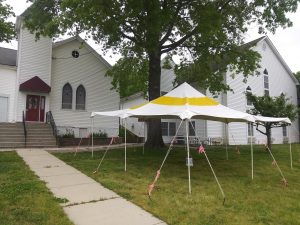Howard County Church Tent Meeting On Hold Awaiting COVID-19 Guidance
SAVAGE, MD — When you mention the phrase “tent meeting”, those with unusually long memories will recall the evangelistic efforts of Pentecostal preacher Oral Roberts. Those with still longer memories might remember hearing about Billy Sunday, who along with many of his contemporaries, took their canvas-topped cues from the Chautauqua movement of the late 1800s.
Tent meetings would eventually give way in the 1950s to mega churches and public auditoriums. Revivalists could then share the Word with the masses in a less rustic setting. But with public gatherings currently on hold due to COVID-19, the greater faith community is looking at the tent meeting model as a workable alternative to shuttered buildings.
Countryside Fellowship Church (CFC) in Savage, Maryland is one many congregations across the land that is stepping into an uncertain future by first turning back the clock. Last Saturday, its spiritual leader, Pastor Dave Robinson – along with a small group of elders – erected an open-sided tent on the church grounds.

The aim of the church was to hold services today for a gathering of no more than 10 people – in strict compliance with local and state-wide COVID-19 restrictions.
Those plans are temporarily in limbo, however, as Pastor Robinson awaits further guidance for reopening churches from Howard County Executive Calvin Ball’s office.
In the meantime, Robinson will continue to live-stream his weekly lessons from the safety of his home. But with modern technology in place, what prompted CFC to go the tent meeting route?
“We’ve been watching as Maryland was entering Stage One of the reopening plan,” explained Robinson, “and have been awaiting information on where Howard County was in that process. Particularly, in regards to houses of worship, and there wasn’t any new information as of last night.
“I’ve been working with the idea that I need to be listening to my county first, and then the State, and finally, Federal guidelines. The county knows what is happening here on the ground, so we’re working with them in concentric rings.
“When Gov. Hogan announced that the State would be entering Stage One, he highly encouraged houses of worship to meet outside. Howard County Executive Calvin Ball did the same thing, though he limited it to 10 people for church gatherings that are held outside.
“The thought from all the information that we were able to get – which admittedly is limited at the moment – was that it would be safer outdoors and that we can use a tent. So, we decided to set it up and meet outside.”
Why was the number 10 selected? Could this be in consideration of Jewish tradition?
“I have not heard any guidance for that. My impression is, 10 was entirely a medically derived number; what’s the probability and the risk of infection if somebody should have it? So, if you’re going to say we want groups to be limited in size, they kind of have to pick a number that they thought was sufficiently low to reduce transmission of the virus.”
What kind of service would CFC be able to offer in an outdoor setting?
“It would be as normal a service as possible.
“We have a fair bit of singing during our usual hour and 20 minute service. We’ll have to evaluate whether or not we can do that during this time, of course. Otherwise, we have a 25 or 30 minute sermon, and we take communion every week.”
Is communion a good idea in the midst of a contagion?
“We’ve been looking at different ways of doing communion. Normally, we pass the elements amongst us, but that would be a problem with social distancing. I was able to purchase some of those individually self-contained communion elements. That will mean minimal contact between servers and congregation members. So in the end, we’ll have a slightly shorter service without as much singing. But I would try to make it as normal as possible.”
Robinson sees the delay as somewhat frustrating; however, he completely understands and respectfully defers to the guidance of Howard County health officials.
“I was waiting to see whether or not we could do it, and if so, how we will need to proceed.”
Robinson said he was encouraged by President Trump’s recent declaration that churches be recognized as essential, but he doesn’t think legislative action should be the deciding factor.

(credit Mark Wigley)
“We aren’t trying to make our decisions on a political basis, but more on a medical basis. What’s best for the people of our church and for the broader community?”
For the people of Savage, caution remains the order of the day. COVID-19 infections spiked last week in Howard County, leaving most area residents content to stay home. Which is where Robinson and his flock will be at 10:30 Sunday morning, as he once again delivers his weekly message virtually.
“We have been live-streaming a sermon on Sunday morning since mid-late March. We’ve also had several Zoom-styled conversations.
“Even so, virus restrictions have affected other areas of my ministry.
“I normally get together with other Howard County pastors on a monthly basis, and we have not been able to do that. There is a food pantry at the Baptist Church in town. My understanding is that that closed early on, though I believe they are continuing to provide food on a drive-up basis.
“The virus has also affected my ability to go visit people. Like everybody else, I’ve been staying pretty close to home. To maintain contact, we have been relying on email and such. So yes, I would say there are several different ways that it has affected the overall ministry.”
Robinson said that, while services are hold for now, the tent will remain in place – poised to welcome both congregants and curious neighbors whenever the restrictions are modified or lifted.
“I’m hoping that Howard County will join all of Maryland as we enter into Stage One. In which case, we would be able to meet at 60% capacity. I think at that point it would be much easier to say, ‘Okay, let’s have services with everyone who’s willing to attend, and continue to stream those services for those who are not able to attend.’

(RNS photo courtesy Teresa Myers)
“How long we’d continue to meet in the tent would depend on county guidance. Of course, I can just envision services in the middle of August, when it is 90 degrees with 95% humidity, and we are wishing we could go into the air-conditioned building.
“Ultimately, the most important factor to me in deciding whether or not to meet is the overall health of individuals in my congregation. We are trending towards being on the older end of the spectrum, so many of our people would fall into the higher risk category, according to the CDC guidelines.
“Again, when our county moves into phase one, I’d like our plans to meet as a congregation based on solid medical demographic information.”
We wondered, in closing, what Pastor Robinson has been virtually offering his flock in the way of comfort or encouragement during this COVID-19 crisis?
“I’ve been trying to impress upon them our reliance on Christ. Events like this don’t surprise God, and we have a real opportunity to be the hands and feet of Jesus. That we can reach out and help people; that we can offer them hope. That we can help them physically, if necessary, or spiritually and emotionally as well.
“I just want them to know that there are lots of ways in which we can continue to be the Church without physically meeting at this time.”
* * * * *
(Note: This article was updated for clarity)

Anthony C. Hayes is an actor, author, raconteur, rapscallion and bon vivant. A one-time newsboy for the Evening Sun and professional presence at the Washington Herald, Tony’s poetry, photography, humor, and prose have also been featured in Smile, Hon, You’re in Baltimore!, Destination Maryland, Magic Octopus Magazine, Los Angeles Post-Examiner, Voice of Baltimore, SmartCEO, Alvarez Fiction, and Tales of Blood and Roses. If you notice that his work has been purloined, please let him know. As the Good Book says, “Thou shalt not steal.”
